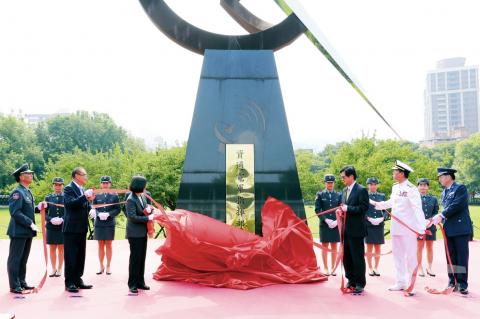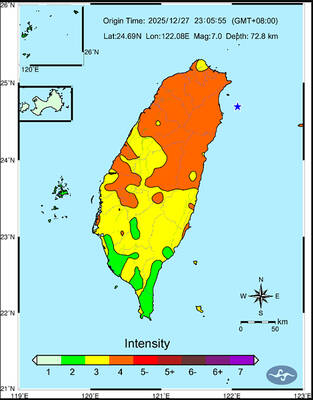The threat from state-sponsored cyberattacks on the nation’s digital infrastructure, including those directed by Beijing-affiliated groups, has increased in sophistication and severity over the past year, the Department of Cyber Security said yesterday.
Last year, Chinese hackers mounted 288 successful cyberattacks on the government’s systems, or 80 percent of the total of 360 successful attacks that the department discovered, department Director Chien Hung-wei (簡宏偉) said.
Each month, the government’s systems are subjected to anywhere between 20 million and 40 million attacks, in addition to billions of probing actions made by hackers looking for weaknesses, he said.

Photo: courtesy of Military News Agency
These actions are initiated by hackers from around the world, though groups based in China are believed to be involved in many of them, Chien said.
The overwhelming majority of cyberattacks are level 1 or level 2 events that result in unauthorized changes to Web pages or other minor damage, he said.
However, the government’s digital domains suffered 10 level 3 incidents, which might have compromised personal data stored on the affected systems, he said.
While there were no successful level 4 attacks — the highest threat level — against the nation’s infrastructure, Chinese hackers had improved the success rate of their attacks, he said.
“The increasing precision of Chinese attacks is a matter of concern for this department,” Chien said.
Hackers route their attacks through servers in the US, Russia, EU member states and other nations, which makes pinpointing an attack’s point of origin difficult, he said.
However, the department is able to identify specific patterns, traits and other modes of operation that are associated with China-sponsored hackers, including the presence of certain characters or styles of coding used in hacking tools, he said.
Hackers from China, North Korea and Russia have been highly active, and Taiwan often serves as a testing ground for new hack tools or techniques before their deployment against targets in other nations, he said.
As a result, foreign governments have expressed an interest in gaining access to the information the department has collected on cyberattacks directed against Taiwan, he said.
The department is overseeing the government’s efforts to develop a system of defense to shield its core computer systems, infrastructure and sensitive data from cyberattacks, Chien said.
The defensive system would involve building up defenses at each of the government’s Web portals and each of the office domains connected to them, he said.
Furthermore, government offices need to communicate with each other and share information about cyberattacks to coordinate their security efforts and discern emerging threats, he said.
An academic, on the day of being nominated a Cabinet official, had received an e-mail with an embedded virus that was designed to penetrate the government’s internal networks, said an official, who asked not to be named.

A magnitude 7.0 earthquake struck off Yilan at 11:05pm yesterday, the Central Weather Administration (CWA) said. The epicenter was located at sea, about 32.3km east of Yilan County Hall, at a depth of 72.8km, CWA data showed There were no immediate reports of damage. The intensity of the quake, which gauges the actual effect of a seismic event, measured 4 in Yilan County area on Taiwan’s seven-tier intensity scale, the data showed. It measured 4 in other parts of eastern, northern and central Taiwan as well as Tainan, and 3 in Kaohsiung and Pingtung County, and 2 in Lienchiang and Penghu counties and 1

FOREIGN INTERFERENCE: Beijing would likely intensify public opinion warfare in next year’s local elections to prevent Lai from getting re-elected, the ‘Yomiuri Shimbun’ said Internal documents from a Chinese artificial intelligence (AI) company indicated that China has been using the technology to intervene in foreign elections, including propaganda targeting Taiwan’s local elections next year and presidential elections in 2028, a Japanese newspaper reported yesterday. The Institute of National Security of Vanderbilt University obtained nearly 400 pages of documents from GoLaxy, a company with ties to the Chinese government, and found evidence that it had apparently deployed sophisticated, AI-driven propaganda campaigns in Hong Kong and Taiwan to shape public opinion, the Yomiuri Shimbun reported. GoLaxy provides insights, situation analysis and public opinion-shaping technology by conducting network surveillance

Taiwan is gearing up to celebrate the New Year at events across the country, headlined by the annual countdown and Taipei 101 fireworks display at midnight. Many of the events are to be livesteamed online. See below for lineups and links: Taipei Taipei’s New Year’s Party 2026 is to begin at 7pm and run until 1am, with the theme “Sailing to the Future.” South Korean girl group KARA is headlining the concert at Taipei City Hall Plaza, with additional performances by Amber An (安心亞), Nick Chou (周湯豪), hip-hop trio Nine One One (玖壹壹), Bii (畢書盡), girl group Genblue (幻藍小熊) and more. The festivities are to

AFTERMATH: The Taipei City Government said it received 39 minor incident reports including gas leaks, water leaks and outages, and a damaged traffic signal A magnitude 7.0 earthquake struck off Taiwan’s northeastern coast late on Saturday, producing only two major aftershocks as of yesterday noon, the Central Weather Administration (CWA) said. The limited aftershocks contrast with last year’s major earthquake in Hualien County, as Saturday’s earthquake occurred at a greater depth in a subduction zone. Saturday’s earthquake struck at 11:05pm, with its hypocenter about 32.3km east of Yilan County Hall, at a depth of 72.8km. Shaking was felt in 17 administrative regions north of Tainan and in eastern Taiwan, reaching intensity level 4 on Taiwan’s seven-tier seismic scale, the CWA said. In Hualien, the